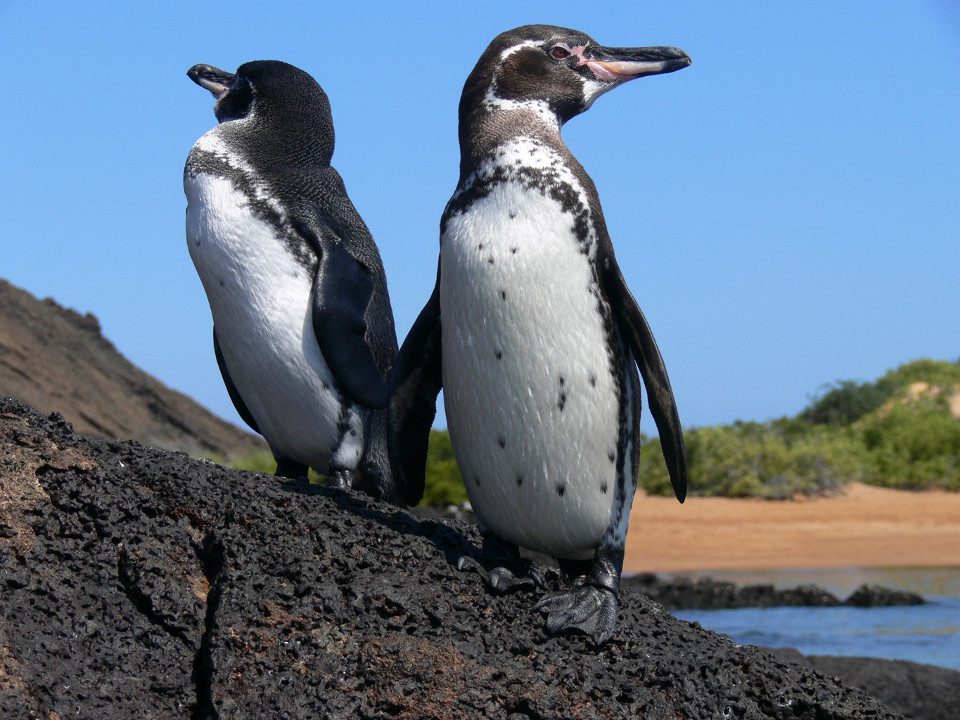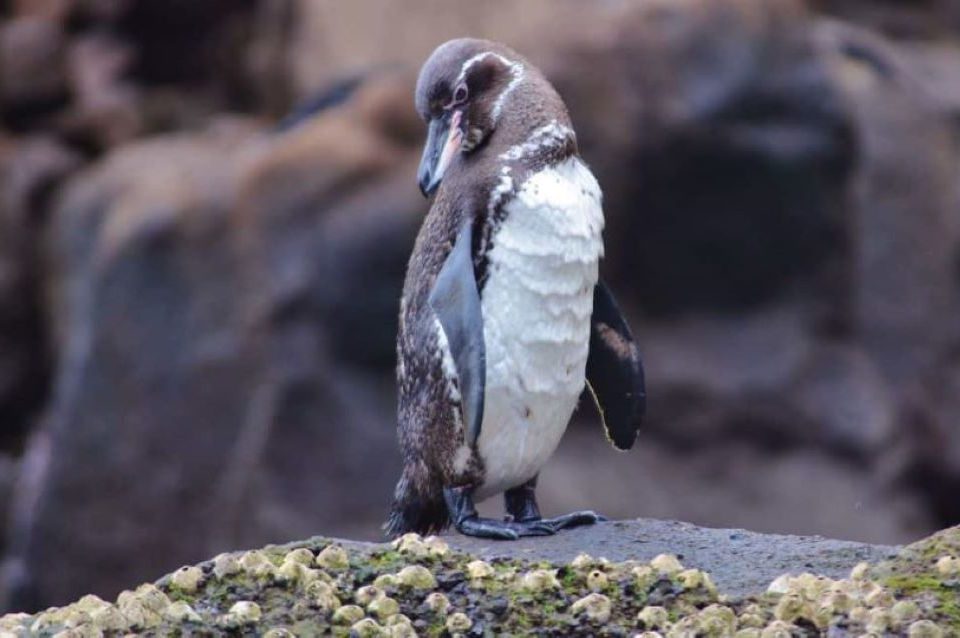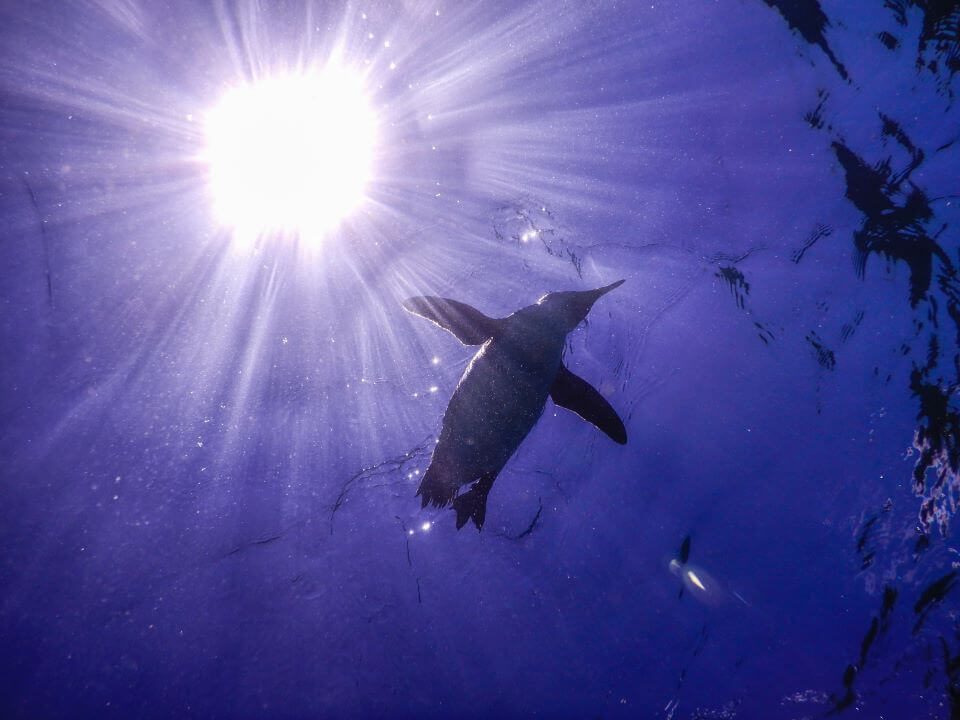The Galapagos Archipelago remained one of the best-hidden secrets in the world for thousands and thousands of years, and has only recently begun to reveal its mysteries to mankind. Penguins are built for the cold, so the fact that this equatorial archipelago is able to support a species of penguin amongst its barren deserts, tropical forests and temperatures of up to 38°C is truly a wonder. The Galapagos tropical penguin is the only penguin species in the world that is located so far north, and more surprisingly that occasionally crosses the equator. Thus, in order to survive it has developed a series of behavioral and physical adaptations.

Surviving the tropics
The Galapagos tropical penguin’s body is specifically adapted so that it can survive in the warm Galapagos climate, and one of its most important adaptations is its small size. The Galapagos tropical penguin is the third smallest in the world (with a maximum height of 20 inches), and as such, it is able to squeeze into small caves and crevasses in the cliffs to protect itself from the sun rays. Also because of their small size, the penguins do not require much space. Considering that the Galapagos tropical penguin has the smallest breeding ground of all other penguins, this is very important. However, particularly significant is that with warmer temperatures, marine life decreases, which means that the penguin’s main food source does, too. This is generally not a problem in the Galapagos, as ocean currents such as the Humboldt bring cool waters to the islands. However, during climatic oscillations such as El Niño, conditions can become dangerous for the penguin and so its small size becomes a strength, as it requires smaller amounts of food.
TALK TO A DESTINATION EXPERT

Diego Zapata

Rosa Mena

Sandy Lara

Diego Zapata

Rosa Mena

Sandy Lara
On the other hand, their behavior also reflects the warm climate in which they live. It is not unusual to see the birds holding their flippers away from their body so that heat may be released from the exposed underparts of their flippers. They also use their flippers to shade their feet, which, unprotected by feathers, can easily burn. The penguins are further able to disperse heat through increased blood flow to these exposed areas and by panting so that heat can evaporate from their throat and airways. However, at the end of the day, the best technique is going for a swim in the marvelous Galapagos waters, cooled by the Humboldt Current and oceanic upwelling. Penguins, in general, spend the majority of their time in the water, and Galapagos penguins are no different.

The Humboldt Current

The Galapagos tropical penguin is closely related to the Humboldt penguin, which can be found along the coast of Chile and Peru, and it is very possible that its ancestor originated in these lands and arrived to the archipelago via one of the greatest life supports of the Galapagos, the Humboldt Current. The Humboldt Current originates in the rich, cold Antarctic waters, from where it travels north along the western coast of South America and turns west at the equator, bringing cool and incredibly rich waters to the Galapagos Islands.
The Galapagos tropical penguin is highly dependent on this current, so much so that its distribution is directly related to its flow, with over 80% of the population on the western islands of Fernandina and Isabela (and the remainder on Santiago, Santa Cruz, Floreana and Bartolome islands). The nutrient-rich waters attract krill and small crustaceans, as well as larger organisms such as fish and squid, which the penguins feed on.
Lurking danger for the Galapagos Tropical Penguin
However, because of the level of dependence the Galapagos tropical penguin has on the Humboldt Current, it is highly susceptible to climate fluctuations, such as those resulting from climate change or El Niño. Furthermore, this bird is the rarest and most endangered species of penguin in the world, resulting in a small gene pool that makes it difficult for the penguin to withstand these events, as well as disease. For example, during the 1982-1983 El Niño around 77% of the population died, and its survival was further threatened just 15 years later with the 1997-1998 El Niño. Sadly these extreme climate events appear to be becoming more frequent and are presenting serious threats to the penguin’s survival.
Furthermore, the Galapagos tropical penguin has had trouble breeding. This is largely due to the destruction of their nests and in fact, many of those used 40 years ago have either been flooded, destroyed or are now used by iguanas. This issue is further complicated by the fact that the penguins are hunted by introduced animals. The islands have very few escape routes for the penguins, so unless they can hide in cracks in the rocks, the penguins have little other option than to run to the water, which proves difficult for chicks and juvenile birds. Conservation groups have been working to help the penguins and, as a part of these efforts, artificial nests were built around their breeding sites to increase their reproductive success. Luckily, the population has experienced growth in recent years and 1,000 individuals were counted in 2007; however, these numbers are still very fragile.
Swimming with a Galapagos tropical penguin
Regardless of their difficult situation, Galapagos penguins continue to be one of the most iconic animals in the archipelago and offer one of the most once-in-a-lifetime opportunities in the Galapagos – swimming with a penguin in tropical waters: imagine snorkeling through rainbow shoals of parrotfish, as a Galapagos tropical penguin dives amidst them. A variety of expedition itineraries offer this “only in the Galapagos” experience. The most popular visitors sites for observing these birds are Bartolome, Floreana, Chinese Hat, Punta Espinoza, and Punta Vicente Roca.

Javier Garcia

Eduardo Silva

Carolina Escobar
START PLANNING YOUR TRIP

Javier Garcia

Eduardo Silva

Carolina Escobar
Get in touch for more
CONTACT US


